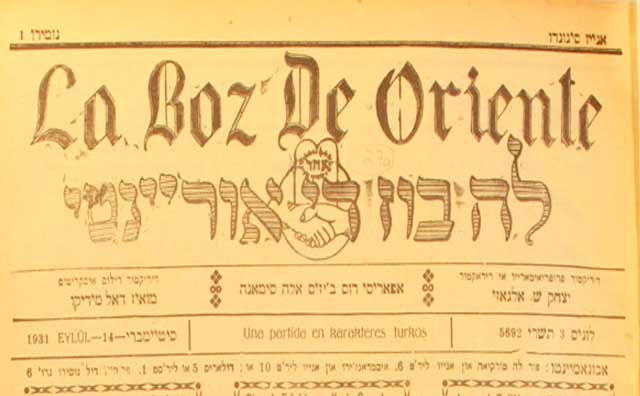<h2>What is Ladino ?</h2>
The Iberian peninsula was the center par excellence of the Jewish culture until the expulsion of all the Hebrews was decreed at the end of Century XV. Until that time, Spain was the country with the largest Jewish community in the world, with a prosperous presence in many cities. When they had to flee from the persecution to other places, the Jews took with them the Spanish culture, or rather Jewish-Spanish, implanting itself in an infinity of geographical points along four continents.
In the realm of these Serfardi communities, customs, the language (ladino or judeo-español) and the different cultural expressions in which the press played an important vehicular role from the mid-nineteenth century until the Shoah (Holocaust or Final Solution) survived. The Sefarad-Israel center in Madrid has exhibited since yesterday a collection of original copies of half a hundred of these headwaters, whose cultural and historical value is immense. It is the first monographic exhibition of these characteristics that is celebrated in the city, under the title “Of good ink, an exhibition that recreates 150 years of press in Ladino”.
W-ladino-080612
The Ladino press evolved parallel to the Sephardic culture. Changes in writing, debates on linguistic standardization, the geographical distribution of these communities, their weight in host societies or their moments of splendor and, finally, of decadence, have been reflected in the rich production of their publications. Some testimonial jewels, as explained by curator of the exhibition and specialist in Judeo-Spanish bibliography Uriel Macías, “had a great importance among the Sephardi as a way of access to information, dissemination of ideas and cultural strengthening.” The director of the Sefarad-Israel center, Florentino Portero, underlines the documentary value of these headers that show the Spanish sentiment of the thousands of Jews expelled from Spain and their will to maintain the culture of their homeland in the diaspora.
The first copy of Sephardic language newspaper was printed in 1842 (La Vara, New York). Since then, new headwinds have not ceased until more than 300 have been recorded throughout history. Its period of greatest splendor is between 1875 and 1940, coinciding with the eve of the entrance of the Nazis in the Greek city of Thessaloniki, the nerve center of the Sephardic community that came to represent almost half the population. During these 65 years “the Sephardic press enjoyed an enormous dynamism in different cities”, attending to a very diverse ideological and thematic plurality, notes Macias. From Cairo to New York, through Vienna or Alexandria, the Judeo-Spanish press enjoyed great importance and had a relative longevity, according to which cases.
Periodicals of generalist, satirical, cultural or political information (such as the workers’ movement, Zionism and many other ideological currents) formed a wide and varied spectrum in different places and with different objectives, but with the common denominator of being the means of communication Of Spaniards in the diaspora. At present most of these headwaters have become museum pieces, with the exception of a cultural magazine or the Shalom newspaper, published today in Istanbul, which at 60 years of life only has a page of twenty written In Ladino. After the 1980s the Ladino press became residual coinciding “with the virtual disappearance of the last generation of natural speakers of Judeo-Spanish,” says Macias.
<h2>A language in danger of extinction</h2>
The few publications that have resisted after the shoah and the loss of speakers have a character closer to nostalgia and folklore than to the need to be informed and communicate in the mother tongue. The causes of its disappearance can not be summarized in one, but have been influenced by multiple factors. However, Portero points out as one of the main reasons that “his first reason for being, based on the anomalous circumstances that led to his appearance after the expulsion of the Jews from the peninsula, has already been overcome.”
The final solution of Nazism is another cause of its disappearance. Only in Thessaloniki, the largest community of Spanish Jews at that time, died between 80 and 90% of the Sephardi. In addition, the larger communities were established on the shores of the Mediterranean, where many were killed by the Nazi army and the rest were exiled to the United States or later to Israel. “The Holocaust provoked a move from a boom to a diametrically opposed one,” adds Macias.
Parallel to the Holocaust, the rise of various nationalisms and the disappearance of empires contributed to the Sephardic language and their means of expression were relegated to the background in host communities in favor of national languages. Finally, with the creation of the state of Israel and the increase of the pressure to the Sephardic communities settled in Arab territories, it propitiated that the majority of them emigrate to the new State, decomposing thus the sephardic nuclei where it was spoken and communicated in judeo-Spanish .
This conjunction of factors has caused that today the ladino is considered practically like a dead language. Although preoccupied with disappearance, the interest in the Sephardi continues to grow, whether for intellectual, folk, political or even romantic reasons. Perhaps it is because today the Sephardic has a certain theme theme park, but its footprint in the cultural history of Spain is undeniable and this is the institutional recognition. “The cultural fabric of Spain is a lot of fun and the preservation of the Sephardic legacy is not without threats,” explains the director of the Sefarad-Israel center.
Florentino Portero is difficult to understand Spanish culture without knowing Judaism first, “which is one of its Pillars “. Porter also recalls the link between Christianity and Judaism, as recognized in the Second Vatican Council, as they share the same roots. “It is difficult to understand Christianity without knowing its common points with Judaism,” says Portero.
